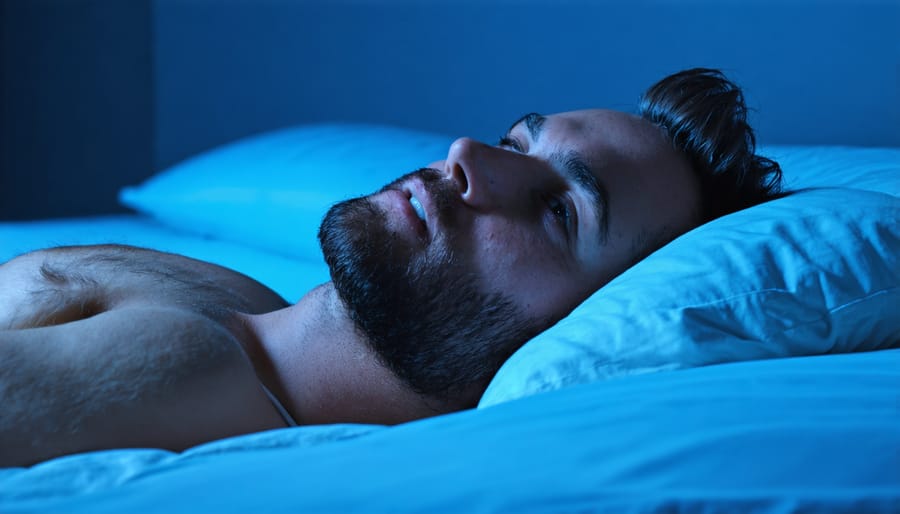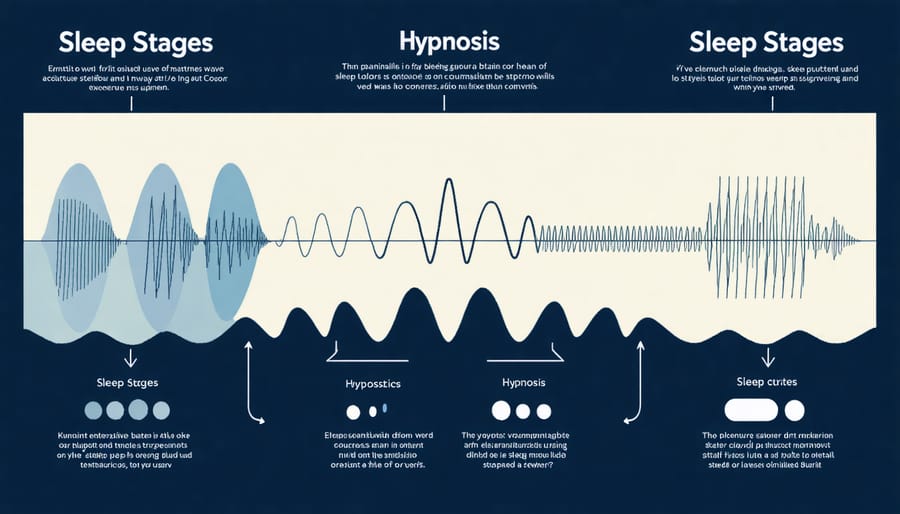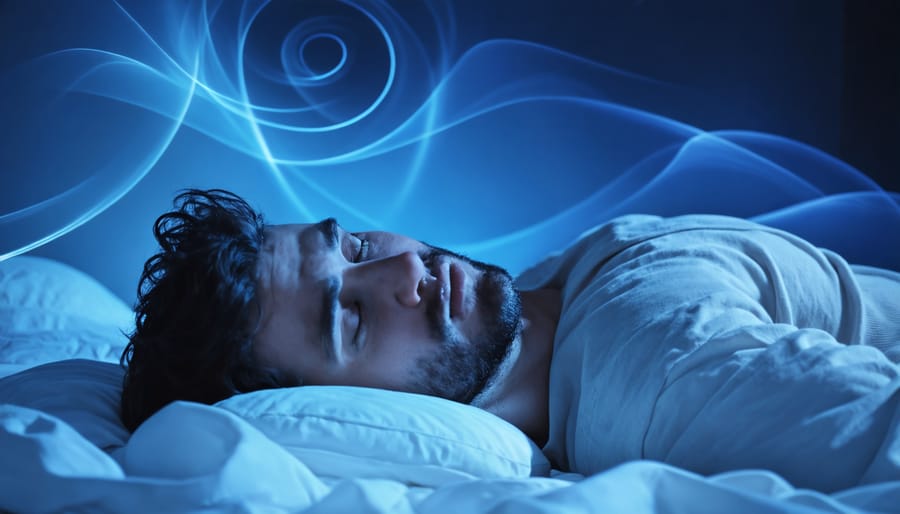Transform your sleep quality tonight with 6-hour sleep hypnosis, a scientifically-backed method that harnesses your mind’s natural ability to enter deep, restorative rest. This powerful technique combines gentle guided meditation with specific brain wave entrainment frequencies, designed to compress the benefits of a full night’s sleep into just six hours. Research shows that properly executed sleep hypnosis can increase deep sleep phases by up to 80%, allowing you to wake refreshed and energized despite a shorter rest period. Whether you’re dealing with a demanding schedule, sleep difficulties, or simply want to optimize your rest, this natural approach offers a practical solution without the side effects of traditional sleep medications. By understanding and working with your brain’s sleep architecture, 6-hour sleep hypnosis helps you achieve more efficient, higher-quality rest while maintaining optimal cognitive function and physical recovery during your waking hours.
Understanding Men’s Sleep Challenges
Common Sleep Disruptions in Men
Men often face unique sleep challenges that can make achieving quality rest more difficult. Work-related stress, particularly in high-pressure careers, can lead to racing thoughts and difficulty winding down at night. Hormonal factors, including changes in testosterone levels, can impact sleep patterns and contribute to sleep disturbances.
Common lifestyle habits among men, such as evening workouts, late-night screen time, and irregular sleep schedules, can significantly disrupt natural sleep cycles. The consumption of caffeine, especially through energy drinks and pre-workout supplements, may also interfere with sleep quality when consumed too close to bedtime.
Additionally, sleep disorders like sleep apnea are more prevalent in men, particularly those who are overweight or over 40. Stress about work responsibilities, financial concerns, and family obligations can create a cycle of worry that makes it challenging to fall asleep naturally.
Understanding these specific challenges is crucial for developing effective sleep strategies, including the use of sleep hypnosis techniques tailored to address these common disruptions.
The Impact of Poor Sleep on Men’s Health
Consistently getting only six hours of sleep can have serious implications for men’s physical and mental health consequences. Research shows that insufficient sleep affects testosterone production, potentially leading to reduced muscle mass, decreased libido, and diminished energy levels. Men who regularly undersleep face an increased risk of heart disease, type 2 diabetes, and weight gain due to disrupted metabolism and elevated stress hormones.
Poor sleep also impairs cognitive function, making it harder to concentrate at work and maintain emotional stability. Memory consolidation suffers, and decision-making abilities become compromised. The immune system weakens, leaving men more susceptible to infections and slower to recover from illness or injury.
Additionally, chronic sleep deprivation can contribute to anxiety, depression, and increased irritability, affecting both personal and professional relationships. These effects often create a cycle where stress makes it even harder to achieve restful sleep, further compounding the health impacts.
What is 6-Hour Sleep Hypnosis?

The Science Behind Sleep Hypnosis
Sleep hypnosis works by inducing specific brainwave patterns that facilitate deeper, more restful sleep. Research shows that this sleep hypnosis technique helps transition the brain from beta waves (associated with active thinking) to alpha waves (relaxation), and eventually to theta waves (deep relaxation and light sleep).
During hypnosis, the brain becomes more receptive to positive suggestions while maintaining a state of focused attention. EEG studies have demonstrated that hypnotic states increase slow-wave sleep patterns, which are crucial for physical restoration and memory consolidation.
The process works by activating the parasympathetic nervous system – our body’s “rest and digest” mode – while reducing activity in the default mode network, the brain region responsible for mind-wandering and worry. This combination helps lower heart rate, decrease blood pressure, and release tension from muscles.
Scientific evidence also shows that regular practice of sleep hypnosis can increase the production of melatonin, our natural sleep hormone, while reducing cortisol levels that might otherwise interfere with quality rest.
Why 6 Hours is the Sweet Spot
Research shows that six hours is the optimal duration for sleep hypnosis sessions, striking a perfect balance between effectiveness and practicality. This timeframe aligns with our natural sleep cycles, typically allowing for four complete sleep cycles of approximately 90 minutes each. During these six hours, your mind and body can achieve the deepest levels of relaxation while maintaining a consistent state of suggestibility.
The six-hour duration also matches the minimum recommended sleep time for adults, making it an ideal choice for those looking to improve their sleep quality without disrupting their daily schedules. Studies indicate that hypnotic suggestions are most effective during the first few hours of sleep, when our brains are most receptive to positive programming.
What’s particularly beneficial about the six-hour format is that it helps prevent the grogginess often associated with longer sleep sessions. It allows you to wake up feeling refreshed and energized, rather than experiencing the sleep inertia that commonly occurs with longer periods of sleep. This duration also provides enough time for the hypnotic suggestions to take effect while ensuring you maintain a healthy sleep-wake cycle.

Getting Started with Sleep Hypnosis
Preparing Your Sleep Environment
Creating an optimal sleep environment is crucial for successful sleep hypnosis. Start by setting your bedroom temperature between 18-20°C (65-68°F), as cooler temperatures promote better sleep. Ensure your room is completely dark by using blackout curtains or a sleep mask, as darkness helps stimulate melatonin production.
Choose comfortable, breathable bedding and wear loose-fitting sleepwear. Remove electronic devices or place them in “do not disturb” mode to minimize distractions. Consider using white noise or nature sounds to mask disruptive environmental noises.
The position of your body matters too. Lie on your back with your head slightly elevated and arms resting comfortably at your sides. This position helps maintain proper breathing and reduces physical tension during the hypnosis session.
Before beginning, ensure you won’t be disturbed for at least 6 hours. Let family members know you’re starting your sleep session, and consider hanging a “Do Not Disturb” sign on your door if necessary. These preparations will help you maintain uninterrupted focus during your sleep hypnosis practice.

Step-by-Step Implementation Guide
Begin by finding a quiet, comfortable space where you won’t be disturbed. Set aside 15-20 minutes before your target bedtime to start the process. Lie down in your bed and take several deep breaths to relax your body.
Start by focusing on progressive muscle relaxation, tensing and releasing each muscle group from your toes to your head. Once physically relaxed, play your chosen sleep hypnosis audio recording. These are readily available through reputable wellness apps or websites.
As you listen, maintain a passive attitude – don’t try to force yourself to sleep or analyze the process. If your mind wanders, gently bring your attention back to the hypnotic suggestions. Keep the volume at a comfortable level where you can hear the words clearly but aren’t startled by them.
Practice this routine consistently for at least two weeks to establish a pattern. It’s normal if you don’t fall asleep during the first few sessions – the goal is to train your mind to associate these moments with relaxation and sleep. If you wake up during the night, you can replay the recording or use the techniques you’ve learned to help you drift back to sleep.
Common Challenges and Solutions
While sleep hypnosis can be effective, some common challenges include difficulty maintaining focus, environmental distractions, and initial skepticism about the process. To stay focused, try using noise-canceling headphones and creating a dedicated relaxation space. If your mind wanders, gently redirect your attention back to the hypnotic suggestions without self-judgment. For those experiencing doubts, start with short sessions and gradually increase duration as you become more comfortable with the practice. Technical issues like poor audio quality or inappropriate volume levels can be resolved by using high-quality recordings and testing sound levels before beginning. Remember that consistency is key – even if results aren’t immediate, regular practice typically leads to improved outcomes within a few weeks.
Maximizing the Benefits
Complementary Sleep Practices
To maximize the benefits of sleep hypnosis, incorporate these supportive practices into your daily routine. Create a consistent bedtime schedule, aiming to sleep and wake at the same times each day. Establish a relaxing pre-sleep ritual that might include gentle stretching, meditation, or reading. Keep your bedroom cool, dark, and quiet, with temperatures between 18-21°C (65-70°F). Limit screen time at least one hour before bed, as blue light can interfere with natural sleep patterns. Consider using white noise or nature sounds to mask disruptive environmental noise. Stay active during the day, but avoid intense exercise close to bedtime. Maintain a healthy diet and avoid heavy meals, caffeine, and alcohol in the evening hours. These practices work synergistically with sleep hypnosis to create optimal conditions for quality rest and recovery.
Tracking Your Progress
To effectively monitor your progress with sleep hypnosis, maintain a sleep journal documenting your nightly routine and morning energy levels. Record your bedtime, wake time, and how refreshed you feel upon waking. Track any changes in your ability to fall asleep and stay asleep throughout the night. Note the specific hypnosis sessions you use and their effectiveness.
Many sleep tracking apps and wearable devices can provide valuable data about your sleep cycles and overall sleep quality. Pay attention to changes in your daytime alertness, mood, and productivity. Look for improvements in your ability to function on six hours of sleep and whether you feel more rested than before starting sleep hypnosis.
Consider taking weekly photos of yourself to observe physical changes like reduced under-eye circles or improved skin tone. Share your progress with a healthcare provider or sleep specialist who can help interpret your results and make necessary adjustments to your sleep hypnosis routine.
Sleep hypnosis offers a natural and effective approach to improving your sleep quality, particularly when aiming for a 6-hour sleep schedule. Throughout this guide, we’ve explored how this technique can help you maximize rest during shorter sleep periods, making it an invaluable tool for those with busy lifestyles or specific sleep requirements.
Remember that consistency is key when implementing sleep hypnosis into your routine. Start by creating a calm bedroom environment, following the suggested preparation steps, and giving yourself time to adjust to the practice. While results may vary from person to person, many users report feeling more refreshed and energized even with 6 hours of sleep when using hypnosis techniques regularly.
Consider beginning with guided recordings specifically designed for 6-hour sleep cycles, then gradually develop your personal practice as you become more comfortable with the technique. If you’re struggling with sleep quality or adapting to a shorter sleep schedule, sleep hypnosis could be the solution you’re looking for.
Always consult with a healthcare provider before making significant changes to your sleep schedule, and remember that quality sleep is fundamental to your overall health and well-being.

